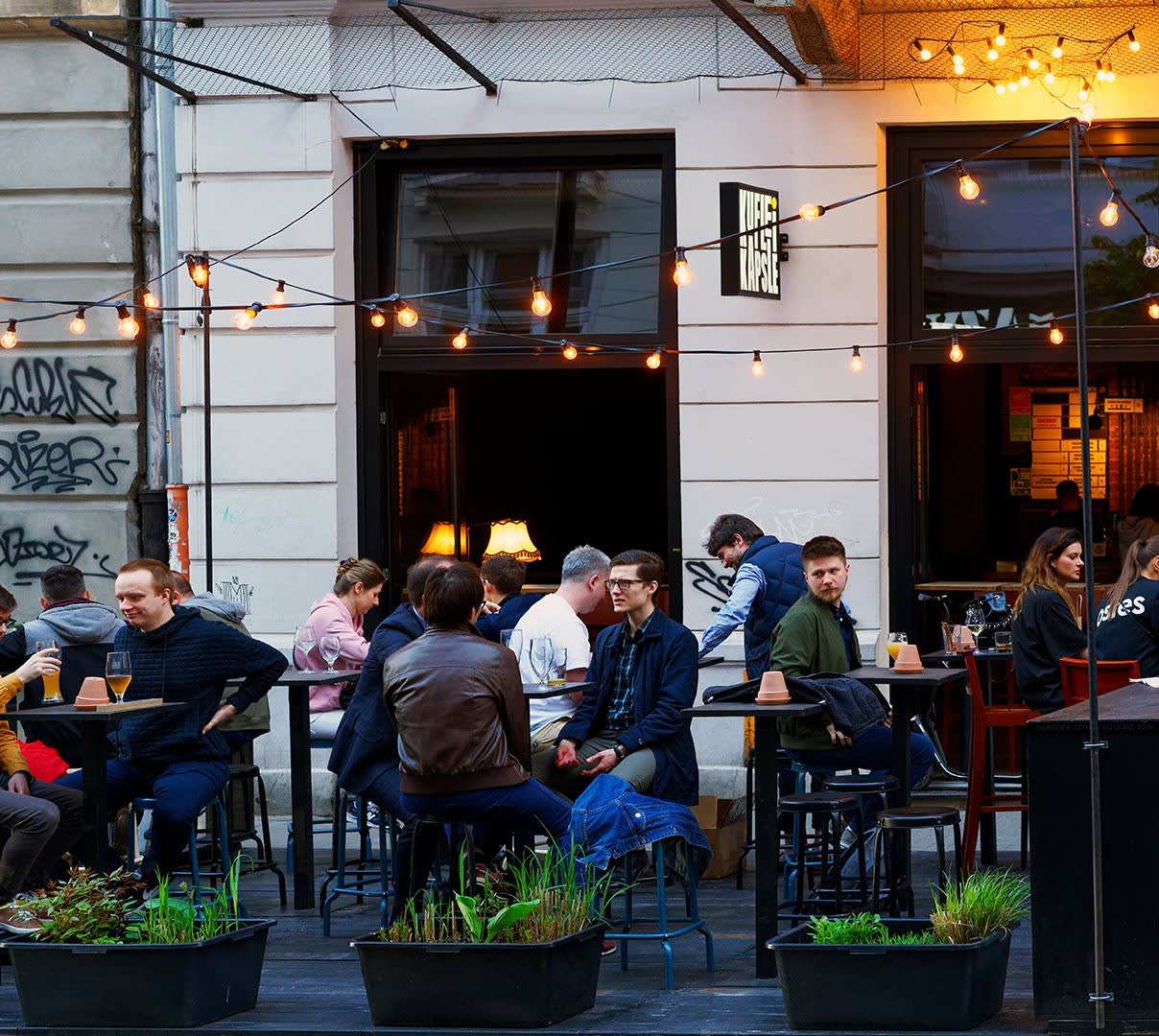It’s time to take it outside. Whatever the weather, diners crave patio spaces where great meals and good company come together in the open air — and this isn’t a fleeting trend.
As cities eased up on outdoor dining restrictions during the pandemic, this seating option offered a lifeline to restaurateurs and restaurant-goers alike. Patios, parklets, and sidewalk terraces sprung up, with diners delighting in all the new al fresco options.
In fact, the National Restaurant Association’s 2022 report indicated that outdoor seating helped some restaurants outstrip their competitors. According to the study, 40% of people said that an outdoor dining area would “make them more likely to choose one restaurant over another, similar one.”
Now, many restaurants are keeping their patios open year-round in response to popular demand. This has led many municipalities to permanently ease their restrictions, offering restaurants more opportunities to expand into the great outdoors.
Summer or winter, outdoor dining is here to stay. Here’s how you can make it work for you.
7 outdoor seating tips for restaurants
You’ve got the space, so how do you create an outdoor dining setup that will get guests clamoring for a seat at the table? There are many things to consider, so here’s a handy guide to help you plan your patio.
1. Review the required permits and regulations
Many cities loosened the reins on outdoor dining during the pandemic, but some, like Los Angeles, are now clamping back down. Avoid the red tape by checking zoning restrictions, capacity limits, health, and safety rules, and opening-hour regulations, as well as getting all the building permits and business licenses you need beforehand.
2. Double down on cleanliness
The open air might be refreshing, but those bracing breezes also blow in more than their fair share of dirt. To keep your outdoor dining area clean, regularly sanitize all outdoor tables, chairs, umbrella stands, and server stations — and store soft furnishings somewhere they can’t be damaged by bad weather.
3. Provide a comfortable distance between tables
According to an oft-referenced study by Cornell University, the distance between tables is a crucial detail for diners. Too tight and the space gets cramped; too distant and the place loses profit. While the industry standard is to place tables 24-30 inches apart, every restaurant needs to find its own vibe. Create an efficient floor plan that is easy to navigate and makes guests feel separated from foot and vehicle traffic.
4. Take a thoughtful approach to lighting
Lighting is paramount. It sets the mood. It highlights design features. And, more practically, lighting is also an important outdoor dining safety precaution. Outdoor lights need to withstand harsh weather while adding to the aesthetic. Want to keep it simple? Battery-powered table lanterns are cute, while globe string lights are trendy and affordable.
5. Focus on accessibility
With today’s expanded outdoor dining regulations, restaurants are able to be a lot more creative with their al fresco seating areas. However, every diner’s needs are different, so ensure your space can be enjoyed by guests of all abilities. Offer accessible dining tables, and if your sidewalk seating extends beyond a raised curb, build a ramp or add tables on a more level setting.
6. Embrace mobile menus
Patios and other outdoor areas can get windy, making menus a little hard to pin down: the last thing you want is to send your waitstaff running down the street after flyaways. QR codes allow diners to peruse the menu on their phones, but why not go one step further? With Tableside Order & Pay, restaurant guests can browse the menu, place an order, and pay directly from their mobile device — which streamlines the serving process, making it a breeze to juggle two dining areas at once.
7. Invest in proper heating and cooling equipment
According to the National Restaurant Association, 60.5 degrees Fahrenheit (15.8 degrees Celsius) is the lowest temperature guests will tolerate. Depending on your climate, it might be worthwhile investing in heat lamps and blankets, or fans and umbrellas. This will not only make guests more comfortable, but it also means you can extend your outdoor dining season beyond spring and summer.
Balancing indoor and outdoor dining operations
Outdoor dining spaces have different needs from indoor operations. To keep everything running smoothly, use the following tips to develop a game plan for outdoor dining setup, service, and cleanup.
Install easy-access sanitizers
Though your outdoor team may be farther from a sink, make sure they wash their hands after bussing tables and before running food or drinks. An outdoor hand sanitizer station helps servers stay safe on the move.
Maintain a high turnover rate
Outdoor diners may take a more leisurely lunch than usual. To ensure a rapid turnover of guests, staff should check in with outdoor diners frequently. Now that you have extra tables, be sure to add these to your management system. It often makes sense to separate indoor and outdoor service, with waitstaff only assigned to one area or the other.
Place clear signage for outdoor seating
As outdoor dining areas can be separate from the main restaurant, diners may not need to go through the front door — and eager guests might grab a table on the patio without checking in with your hosts. Avoid this classic headache with clear signage in the most visible places to encourage all diners to visit the host stand first. Your servers will thank you.
Prepare for the elements
Wherever you are in the world, weather plays a role in every outdoor meal. Shades and patio umbrellas shield diners from the sun, while canopies and awnings keep the rain off. Maintain this equipment regularly and lock everything down on gusty days. To keep your outdoor dining area open in winter, plan for whatever the weather might throw at you. If your patio has a roof but no walls, invest in clear vinyl curtains and add heat lamps to keep it cozy.
Plan an outdoor menu
Exclusive outdoor menu items are enticing to all diners, be they newcomers or regulars. When creating your outdoor menu, consider items to complement the climate. On warmer days, light and cool options are preferable — such as a burrata salad, ceviche, and refreshing drinks — while your winter offerings may be comfort food to keep outdoor guests warm. Menu items that celebrate the season, from cocktails with fresh herbs in the spring to hearty roasted chicken in the fall, are always a hit outdoors.
Beautify and promote your patio
Terraces, patios, and backyards aren’t just fun for diners: they’re also effective marketing tools. Even a low-budget outdoor restaurant design can transport customers to a piazza in Italy, a café in Paris, or a secret garden in India. Spice up the space with colorful furniture, quirky art, and an aesthetic that invites diners to share their experience online. Read our blog post for more restaurant patio design ideas.
Once your outdoor oasis is ready to welcome guests, showcase your outdoor dining setup on social media and in an email newsletter. Be sure to update your website to highlight any changes. Also, let guests know they can still enjoy all your delicious favorites at home with pickup and delivery.
Managing online orders simultaneously
The fresh attention from outdoor-hungry diners might be welcome, but it comes with some challenges. Orders aren’t just coming in from your outdoor and indoor seating areas: 33% of US consumers are ordering delivery more often than last year.
If you’ve already got a packed patio in addition to guests enjoying your menu inside, online orders could put a strain on your kitchen and staff. It’s important to streamline your back-of-house operations so deliveries don’t impact your on-premise diners. Here are a few strategies to balance on- and off-premise dining operations:
Set up online ordering
Instead of fielding phone calls for takeout, you can generate pickup and delivery orders on DoorDash. You can also use Online Ordering to add a commission-free online ordering system to your own website. That way, your staff won’t have to dedicate any time to taking orders — all they’ll have to do is prep the food and have it ready when the Dasher arrives. There are no monthly software fees for Online Ordering; instead, restaurants pay payment processing fees per order.
Integrate your POS
Make the online ordering process even simpler by integrating your point of sale (POS) system with DoorDash. This will allow you to receive online orders directly to your POS and alleviate pressure on your staff, as no one will need to keep track of orders on another device.
Designate a pickup spot
There are many factors to consider when choosing a place for Dashers and pickup customers to get their orders. This designated spot should be accessible from the entrance, but set off to the side so it doesn’t interrupt the flow of guest traffic. Signage will help guide Dashers and pickup diners to the right place and prevent confusion with on-premise guests.
Set realistic prep times
Keeping an eye on how busy things are in your kitchen will help you adjust your prep times for online orders. DoorDash partners have the option to extend the prep time for each menu item to help manage delivery customer expectations. You can also set your Kitchen Status to Busy, which will let you add even more prep time — and ensure you avoid delays for the Dasher or the customer.
Delegate deliveries to specific hosts
Avoid unnecessary stress by training your staff on the step-by-step procedure of receiving online orders, placing them in food delivery containers, and handing off deliveries. To streamline the process, give just one or two of your employees (per shift) the task of managing deliveries: that way, no orders should get forgotten or go missing.
One final idea for outdoor dining setups
Keep an eye on the calendar — and not just for weather concerns. As the seasons change, you’ll have plenty of opportunities to market your outdoor dining area. Consider how you can use your patio to capitalize on holidays, seasonal themes, or major sporting events. This could play a role in decoration, but also in your menu planning, and even your marketing. Put your patio front and center when promoting your restaurant: this new dining area is an asset that will keep bringing guests to the table, as long as you bring it into the spotlight.
Looking for more engaging ways to market your restaurant throughout the seasons? Download the Restaurant Marketing Calendar & Toolkit for recommendations.





